1395 Private Gerald Gilbert Stanley ALLSEBROOK CC
1st Australian Clearing Hospital
By Robert Simpson
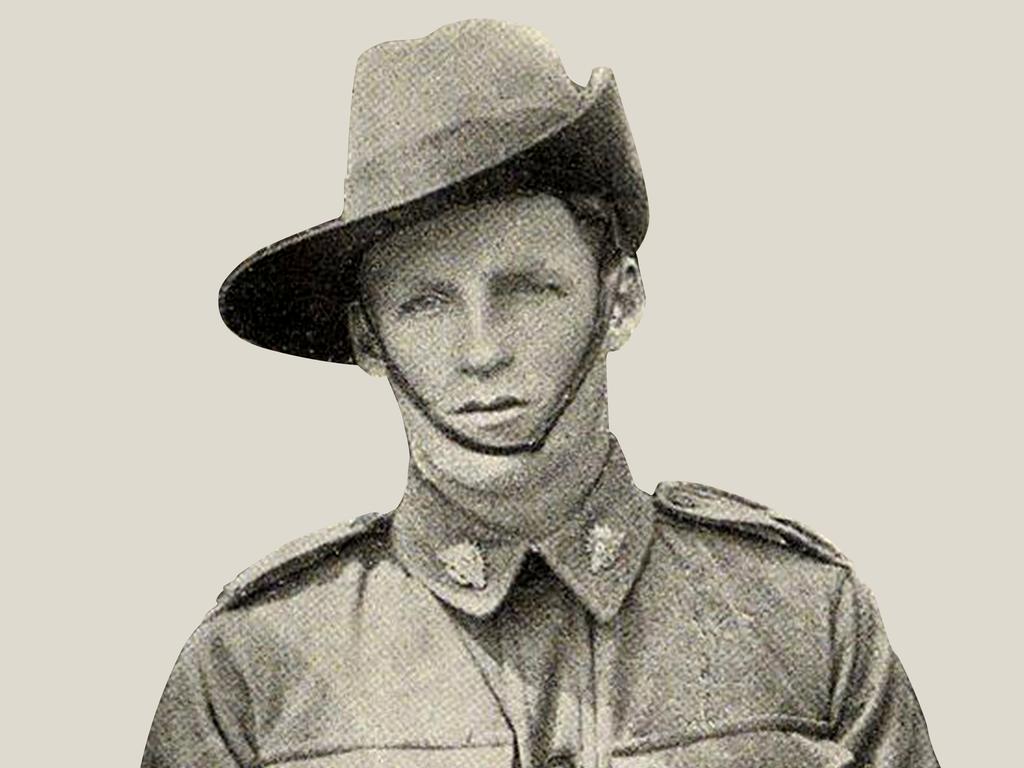 Gerald Gilbert Stanley Allsebrook was born in Hobart, Tasmania on 12 June 1894, a son to William Allsebrook and Agnes Martha Smith. William had been born in 1864 in Hobart and Agnes on 27 July 1863 in Hobart. They had been married on 9 July 1884 in Hobart. The parents of William were Richard Allsebrook and Elizabeth Morris who had married in Tasmania on 4 May 1849 in Hobart. Richard had been sent to Tasmania in 1845 as a convict. In all they had six children. They were living at 16 Star Street, Fitzroy Place, Hobart in the 1919 electoral roll, with William a painter and Agnes doing domestic duties. By the 1922 roll they had moved to 39 Colville Street Hobart with the same occupations. Agnes passed away in Hobart on 3 May 1932 and William died on 15 June 1939 also in Hobart. William and Agnes are both buried in Cornelian Bay Cemetery in area or denomination: Church of England, Section: XX, Site number: Number 160.
Gerald Gilbert Stanley Allsebrook was born in Hobart, Tasmania on 12 June 1894, a son to William Allsebrook and Agnes Martha Smith. William had been born in 1864 in Hobart and Agnes on 27 July 1863 in Hobart. They had been married on 9 July 1884 in Hobart. The parents of William were Richard Allsebrook and Elizabeth Morris who had married in Tasmania on 4 May 1849 in Hobart. Richard had been sent to Tasmania in 1845 as a convict. In all they had six children. They were living at 16 Star Street, Fitzroy Place, Hobart in the 1919 electoral roll, with William a painter and Agnes doing domestic duties. By the 1922 roll they had moved to 39 Colville Street Hobart with the same occupations. Agnes passed away in Hobart on 3 May 1932 and William died on 15 June 1939 also in Hobart. William and Agnes are both buried in Cornelian Bay Cemetery in area or denomination: Church of England, Section: XX, Site number: Number 160. 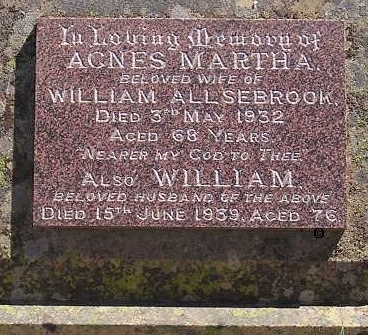
His parent’s grave.
William John Allsebrook was their firstborn and was born on 20 November 1885 in Hobart. He married May Fahey in 1910 in Hobart. The 1922 and 1928 electoral rolls show William Junior living at 39 Colville Street, Battery Point, Hobart and an occupation of driver, but no mention of May. In the 1929 Police Gazette he is in a list of people as having a motor vehicle transferred to him. A Police Gazette dated 27 June 1930 has him recorded as follows ‘PERTH. – WILLIAM ALLSEBROOK (JUN.), 33 Cromwell-street, reports stolen from his disabled motor-car on the Main-road, about 6 miles from Perth, between noon on the 21st and morning of the 22nd instant:- A 6-volt Willard battery, in Masse case; 2 rims and glasses of headlights; and an Eastern ignition distributor; value £20; identifiable.’ He died on 31 March 1935 in Hobart and is buried in Cornelian Bay Cemetery and Crematorium in Church of England, Gg, Number 70. Silfris May Allsebrook was born 0n 4 October 1887 in Hobart. She married Joseph William Kirkby in 1909 in Tasmania. In the 1919 electoral roll they were living at 12 Montpelier Street in Hobart, he was a lineman and Silfris had altered her name to Sylvia and was doing domestic duties. The Advocate of Burnie Tasmania had an entry on 19 May 1931 which read ‘Mr. A. E. Richardson represented the petitioner in a divorce suit brought by Silfris May Kirkby against her husband Joseph William Kirkby. Amy Millbra Howie was cited as co-respondent. Mr. Richardson explained that in November last a decree nisi was obtained by Gordon Howie against his wife Amy Millbra Howie, who was the co-respondent in the present action. The respondent in the present action was the co-respondent in that suit. Joan Hayton, law clerk, gave evidence that a decree nisi was granted to Gordon Howie against his wife, Joseph Kirkby being cited as co-respondent. Witness served the papers on the respondent in the present action at 238 Elizabeth Street. Mrs. Howie answered the door and called Kirkby, who admitted that he was the person named in the petition. Amy Devereux, midwifery nurse, gave evidence of having attended Mrs. Howie in March, 1929. Kirkby was in the house at the time. A decree nisi was granted.’ In 1930 she married Montressor Joseph Hu Arnold in Waverley NSW (her name was recorded as Silfris). She placed a notice in the Hobart Mercury on 3 May 1940 ‘ALLSEBROOK- In loving, memory of my darling mother, who passed away on May 3, 1932; also my dear father, who passed away on June 15. 1939: also my dear brothers, William, who passed away on March 29, 1935, and Gerald, killed in action on Gallipoli, June 20, 1915. At rest. Inserted by her loving daughter and sister, Sylvia Arnold.’ In the 1943 and 1949 electoral rolls they were living at 17 Waterloo Crescent, Montressor was a hairdresser and Silfris was doing home duties. It is not sure when she passed. Bingham Charles Allsebrook was born on 11 June 1889 in Hobart. His birth record surname (and his father’s) is translated as ‘Walsebrook’. No other details of his life can be found. Iris Agnes Fitzroy Allsebrook was born on 2 May 1892 in Hobart. On 26 October 1909 she married Lyndhurst Richard Harcourt McGuffie (1884-1967) in Tasmania. In the 1922 electoral roll they were living at Rokeby Road Bellerive. He was a photographer and she was doing home duties. They moved to Adelaide sometime, as on 25 January 1937 she was admitted to the Adelaide Hospital and was in there for 24 days. Her address was recorded as 47 Myers Street Torrensville. She was admitted into the hospital again on 26 June 1939 and was in there for 6 days. Her occupation was listed as a cleaner. They had moved to 126 Unley Road Unley, Adelaide, South Australia. The South Australia Police Gazette of 18 September 1940 had an entry under Warrants Issued for Mary Anne McGuffie, who was accompanied by Alex Claude Dawe, and who ‘did unlawfully by fraud take away a certain child’, who was Irie (sic) Doris McGuffie (nearly six years old), from her parents, Lyndhurst and Iris. The report went on to give descriptions of both and the child, and that arrest was urgently desired. In the 1943 electoral roll, they had the same address and occupations. It is not sure when she passed away. Ruth Dorothy Allsebrook was born on 3 March 1896 in Hobart, but unfortunately passed away on 18 March 1898 in Hobart. She was buried in Queenborough Cemetery, Sandy Bay. By 1913 the Queenborough Cemetery Company had run out of money to maintain the cemetery and the entire site lay derelict until the Hobart City Council purchased the site in 1915 and later built sports grounds on the lower portion, named Queenborough Oval. The remainder of the cemetery was used until it was closed in 1934 and was later dismantled in 1961 for the construction of The Hutchins School and associated sports grounds. In Peel Street, the headstones of many of the dead have been preserved in a memorial garden. Other headstones from the original Queenborough Cemetery have been removed to a dedicated area at Cornelian Bay Cemetery in New Town. William and Agnes were also guardians for Montressor Joseph Arthur. He served in WW1 with C Section, 7th Field Ambulance as Private 3746. His address was given as Battery Point, Hobart and he was a hairdresser. In May 1915 he was promoted to Sergeant, but asked to revert back to Driver in March 1916. He was ill a couple of times in 1917. In mid-1918 he went AWOL a couple of times. He returned to Australia in March 1919 and was discharged in August. Montressor was entitled to the 1914-15 Star, British War and Victory medals. An article in the Tasmanian News on Thursday 15 August 1907 in page 4 reads ‘ASSAULT. William Hill was charged before the Police Magistrate (Mr W. O. Wise) and L. H. Macleod at the City Police Court this morning with having, on August 9 last, in the Barrack Square, assaulted one Gerald Allsebrook, aged 13 years. He pleaded guilty. The Bench imposed a fine of 5s and 8s costs. Mr C. Davenport Hoggins (Hoggins and Gilmore) appeared for the plaintiff, and Mr David Crisp (Crisp and Crisp) for defendant.’ His name appears in The Mercury in 1909 in a list for the Davey Street team, as ‘G Alsebrook’, who were playing against West Hobart. Gerald played Australian Rules football with North Hobart and was a member of its state premiership-winning team of 1914. The newspapers spelled his name ‘Aulsebrook’ in a lot articles they wrote about games he played in and about him during the war. (There seems to be a family living in Devonport of that name at that time, so the confusion may be due to this). They also recorded his first name initial as ‘O’ due to his nickname ‘Ocker,’ which all his mates called him. In the Daily Post of Hobart on Tuesday 31 March 1914 in page 8 under the title ‘FOOTBALL. NORTH HOBART CLUB, ANNUAL MEETING. There was a large number of members of the North Hobart Football Club present at their annual meeting held in the Masonic Hall last night. Trophies were awarded as follow:’ and the list included ‘O. Aulsebrook; Mr. E. J. O’Brien’s trophy, for most deserving junior player.’ The Critic of Hobart on Friday 1 May 1914 in page 9 had an article about the first match of the year between North Hobart and the Cananore Club. Part of the article read: ‘Aulsebrook and Newman comprised a pair of grafters on their respective wings. Aulsebrook and Newman comprised a pair of grafters, and did more than the (sic) share.’ In a game of North vs South as recorded in The Mercury of 13 July 1914 he is mentioned a few times ‘When Umpire Green set the ball free Flanagan was the first to get it away, and there were some smart interchanges between Dunn Pugh Aulsebrook, and Richardson over the Southern defence lines’… ‘Aulsebrook came to the side and kicked down the centre’ …, ‘ North assailed the Southern position in force, and an injudicious move on Aulsebrook’s part left Whittle an opening which he was quick to seize and running right in, he goaled securely.’…, and ‘with barely six minutes to go Aulsebrook saved a certain goal, but Peden secured and rushed for the opening, sending in a hot shot, which, amid a great volume of shouting J. Dunn arrested with a brilliant mark.’ 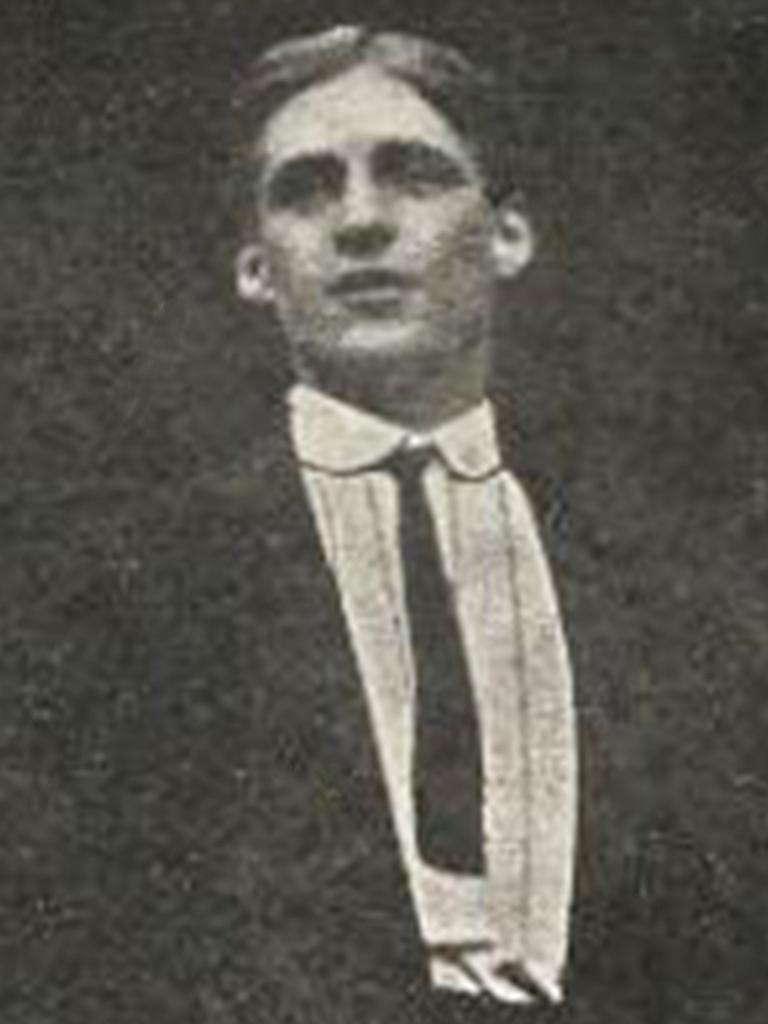
Gerald sometime before the war.
Gerald Allsebrook enlisted with the 1st Australian Clearing Hospital on 21 September 1914 as Private 1395. He stated he had been born in Hobart, was a British born subject, and was a 20-year-old painter who had not been apprenticed and was not married. His next of kin was listed as his father, William Allsebrook of 16 Star Street Hobart. The address was later changed to 39 Colville Street, Battery Point. He had previously served with 2 years in the 23rd AMC. Gerald took the oath on the same day. His description on enlistment was recorded as age 20 years 4 months, height 5-foot 6½ inches, weight 10 stone 9 pounds, chest measurement 33½ to 36½ inches, and a clean complexion with green eyes (both 6/6 vision) and light brown hair. For distinctive marks he had a scar on outside of left leg above knee, and his religious denomination was Church of England. A medical examination on 17 September had considered him fit for active service. The Commander of the 1st Australian Clearing Hospital appointed him to the unit on 21 November 1914 at Claremont Camp. The Mercury of Hobart on Saturday 14 November 1914 in page 6, under the heading ‘TASMANIAN CONTINGENT’ had ‘Members of the North Hobart Football Club assembled the other evening to say farewell to one of their leading players in the person of G. Aulsebrook, who has joined the second Tasmanian Expeditionary Force for service abroad. The occasion was marked by the presentation of a wristlet watch to the player. Mr. W. Leitch, the club’s delegate to the Football League, made the presentation on the club’s behalf, and made reference to the many sterling games the recipient had played for the club. Private Aulsebrook suitably responded.’ The Examiner of Launceston on Monday 16 November 1914 in page 3 added ‘Members of the North Hobart Football Club assembled the other evening to say farewell to one of their leading players in the person of G. Aulsebrook, who has joined the second Tasmanian Expeditionary Force for service abroad. The occasion was marked by the presentation of a wristlet watch to the player. Mr. W. Leitch, the club’s delegate to the Football League, made the presentation on the club’s behalf, and made reference to the many sterling games the recipient had played for the club. Private Aulsebrook suitably responded. He will be remembered here as one of the south’s best representatives in the last North v. South match in Launceston.’ The 1st Australian Casualty Clearing Station (1ACCS) was raised in Hobart and consisted of 93 men including 7 doctors. After some seven weeks of training in camp, the new unit embarked for Egypt on 5 December 1914 and the Gallipoli offensive. The Nominal Roll for the 1st Australian Clearing Hospital that embarked at Melbourne on HMAT Kyarra A55 on 5 December 1914 lists 1395 Private Gerald Allsebrook as a 20-year-old painter of 15 Star Street Hobart and his father William as next of kin at the same address. After embarking his pay was 5 shillings a day, of which half he allocated to Australia. He proceeded to join the MEF for Gallipoli on 7 March 1915. They landed on the beach at Anzac Cove at 11am on 25 April 1915, and remained on a 20-metre stretch of beach through eight months of the Gallipoli campaign. On 5 June 1915 he was fined 5 shillings for being AWOL from his tent at Roll Call. The War Diary for No 1 Australian Casualty Clearing Station for June 1915 had an entry on 14 June at ANZAC, with ‘The hospital was subjected to severe bombardment for a short time with high explosive shells, about 20 fell in vicinity. One patient a stoker F. Upwood was killed No. 1395 Pt. G. Aulsbrook – severely wounded compound fracture of tibia To H.S. Sicilia.’ The diary is in both handwritten and typed formats, with the typed format adding in writing ‘One of the Unit sustained a severe compound fracture of the tibia. Both were transferred to H.S. Sicilia.’ His service records have recorded ‘wounded in action Anzac comp Fract Leg’ on 14 June 1915. The July 1915 dairy has an entry on 15 July at ANZAC with ‘The following names mentioned in Army Corps Routine Orders :-‘ with the list including ‘No.1395. Pte. Aulsebrook. G.’. In his service record is recorded ‘N.R.W. 6/1259 dated 22/6/15 {Confirmation of Cable W.B. 604/769 1/7/15 G.S.W. & Comp. frac. Tibia & Fibula. Died on board “Sicilia” in harbr. Malta 10.10pm 20/6/15’. A report on his death, forwarded to the War Office from the First Clearing Hospital, shows that Private 1395 G Allsebrook died of wounds, received in action, on 20 June 1915 on board HS Sicilia. He had not left a will, but his pay book was not yet to hand. The form was signed in Alexandria on 7 July 1915. Gerald was buried in Pieta Military (New) Cemetery at Malta in Row 1 Grave 2. On 22 June C1752, an extract from Cable WB411 confirmed he died of wounds on HS Sicilia on 20 June 1915. The Mercury of Tasmania has an entry on 2 July 1915 for ‘Allsebrook Gerald G S Pte Death Date 20 Jun 1915 died of wounds’. There is a letter in his service file, but only the last page is visible. It reads ‘His mother as well as myself are deeply anxious to know the particulars I have asked you. If you cannot give me the particulars could you send this (my letter) on to Egypt, or where my son was taken to the Hospital, to those who had charge of him, and they may be able to give the particulars I have asked. I apologise for troubling you, but the deep sorrow & grief to me and his mother must be my excuse. I am, Sir, Your Obedient Servant W Allsebrook, 16 Star St.’ The letter had been written to The Honourable Senator Pearce, Minister of Defence, Melbourne, Victoria. Base Records replied on 14 July 1915 stating ‘In reply to yours of the 7th inst., it is regretted that the only information received was contained in a cable message from Malta, to the effect that your son No. 1395 Private Gerald Allsebrook, 1st Australian Clearing Hospital, was reported as having died of wounds on board the Hospital ship “Sicilia”, on the 20th June, 1915. No further particulars will be available until the necessary official confirming documents have been received from the Front, when you will be immediately notified.’ Gerald was recorded with a special mention in Divisional Orders for gallantry or valuable service rendered during the period from 6 May to 28 June 1915, as recorded in No 16 Part II orders MEF 22 September 1915. Package number 3079, dated 15 December 1915, contained the effects of 1395 Private Gerald Allsebrook 1st CCH AMC and included 3 razors, salts bottle, holdall, postcards, letters and 2 hairbrushes. Package 4412, dated 23 December, contained more of his effects which were letters, photos, coin, pencil and a comb. They were sent to his father, via Thomas Cook and Son on Demosthenes from Egypt, who signed for them on 8 May 1916. On 23 December 1915 army pay book 64 for him was forwarded to Paymaster, as noted in his service record. Form D2416, dated 13 January 1916, to the Officer Commanding 23rd AAMC, Hobart, Tasmania, reads ‘Herewith Record Books, C.M.Form M7-8 with A.I.F. service entered) relating to No. 1395 Private Allsebrook, Gerald Gilbert, 1st Australian Clearing Hospital, Australian Imperial Force, and formerly of your command, reported as – Died of wounds, on board Hospital Ship “Sicilia”, 20th June, 1915.’ It was sent from Base Records, and they also asked for a receipt. The Officer Commanding 23rd AAMC acknowledged receipt of the forms on 21 January 1916 in a letter to Base Records. The Commonwealth War Graves Commission has an entry in the Register of the Graves under Pieta Military Cemetery at Malta for ‘ALLSEBROOK, Pte. Gerald, 1395. 1st Clearing Hosp. Australian Army Medical Corps. Died of wounds 20th June, 1915. A. V. 5.’ He is also recorded in the Roll of Honour 1914-1918 in the front porch of Battery Point St Georges Anglican Church, the Queensborough Sandy Bay book as ‘ALLSEBROOK, Gerald Gilbert Stanley, D: 20 Jun 1915 – 20yrs – Died of wounds at the Dardanelles’, and is remembered in the Hobart Soldier’s Walk Memorial Trees with tree 25 near Davies Avenue. On 14 July 1916 a picture of his grave at Malta was sent to his next of kin. His description on the memorial walk is listed as: Final Rank: Pte Final Unit: 1 Clearing Hospital Aust Medical Corps Regt Number: 1395 Date of Death: 20/06/1915 Cause of Death: Died of Wounds Age at Death: 20 Awards/Citations: Enlistment Date: 21/09/1914 Enlistment Unit: 1st Aust Clearing Hospital Enlistment Rank: Private Place of Enlistment: Hobart Native Place: – Next of Kin: “Son of William Allsebrook 39 Colville St, Battery Point (1918)” Home Address: 16 Star St Battery Point Schooling: Albuera St (Old Model) Occupation: Hairdresser Place of Work: – Religion: Church of England Remarks: Mercury gives address as Star Street. Name misspelt on map as Allesbrook Well known North Hobart Footballer Photograph of grave appears on AWM site (caption gives name as Private C Alles Brook.) Embarkation Roll as “Painter” Cemetery/Memorial: “Pieta Cemetery, Malta” Honour Boards Tas: Albuera St Primary School; Hobart Town Hall; Tas Football League: St George’s Church AWM Roll of Honour: 132/182 Council Tree Number: 19 Planting: 3/08/1918 Below is the plaque with the tree on the memorial walk. 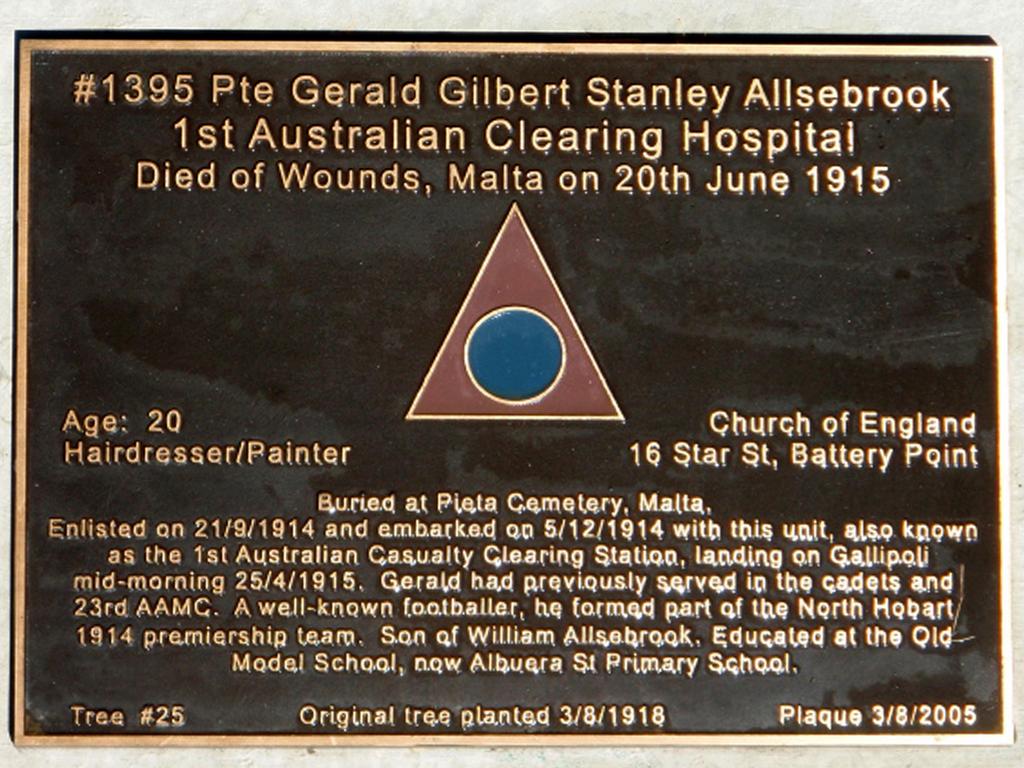
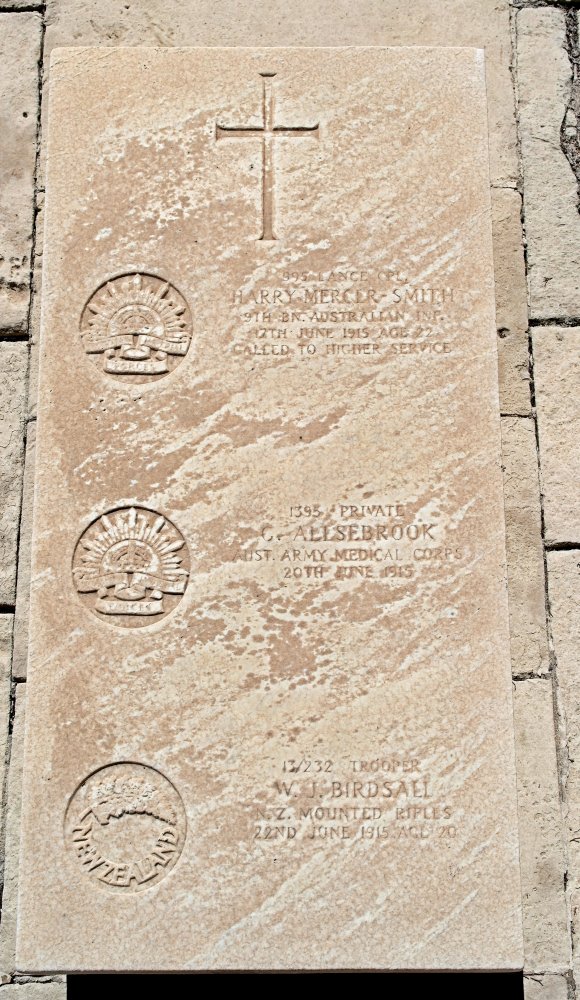
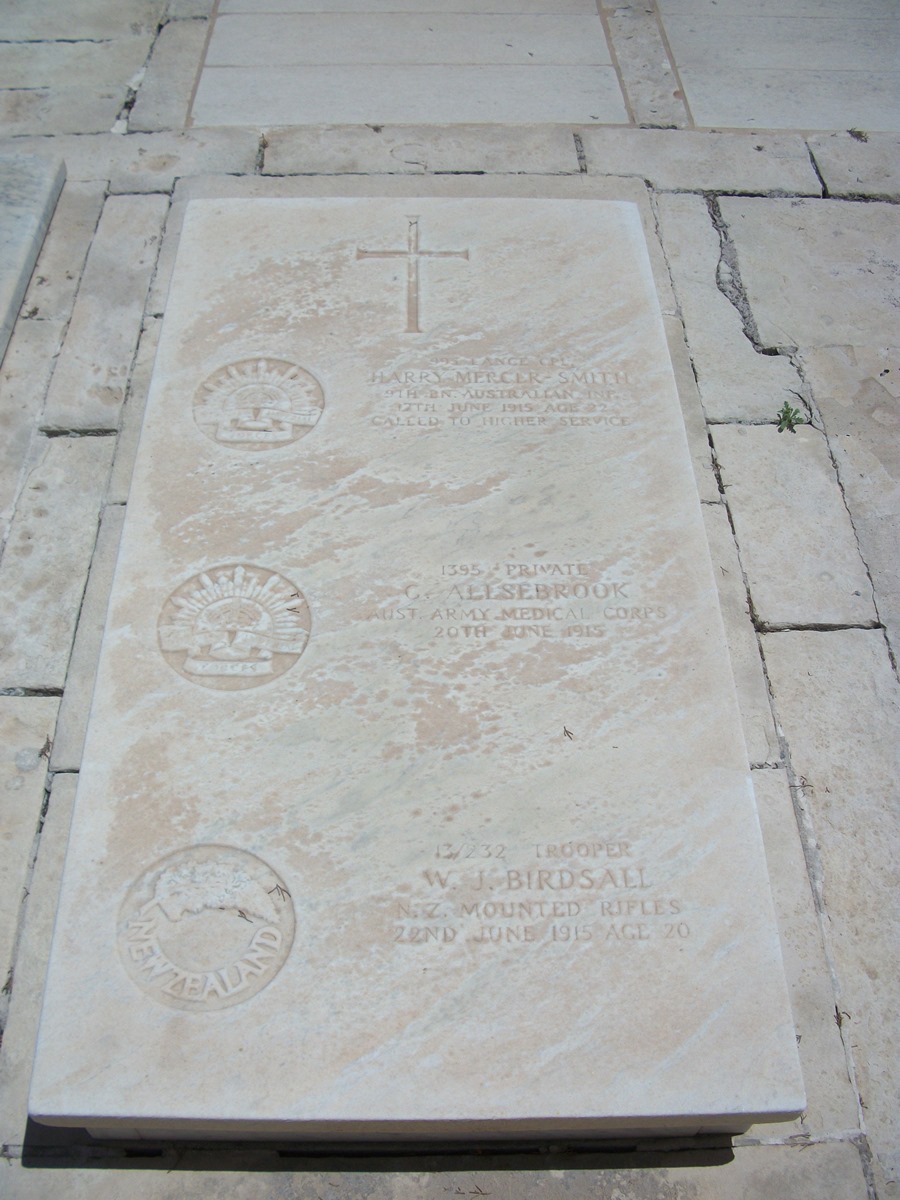 Grave picture P00545.048 from Australian War Memorial. ‘PIETA MILITARY CEMETERY, MALTA. GRAVE OF 995 LANCE CORPORAL HARRY MERCER-SMITH OF THE 9TH BATTALION, AIF, WHO DIED ON 1915-06-17, AGED 22 YEARS, AND ALSO OF 1395 PRIVATE C. ALLES BROOK OF THE AUSTRALIAN ARMY MEDICAL CORPS, WHO DIED ON 1915-06-20. MERCER-SMITH AND ALLES-BROOK BURIED WITH A NEW ZEALAND SOLDIER. (DONOR PRESIDENT OF MALTA)’ Row 1 Grave 2. The First World War Nominal Roll lists 1395 Private Gerald Allsebrook 1st ACS died of wounds on 20 June 1915. A copy of a message from Base Records on 21 December 1918 reads ‘No. 1395, — Private Gerald Allsebrook, 1st Australian Clearing Hospital, wounds received in action — on board, H.S. Sicilia, 20th June, 15. Cable No. M.F.C. 5998, from the Officer Commanding Intermediate Base dated Alexandria, 24th June 1915, confirmed by Army Form B. 104-52, and Army Form B. 2090A, and Cable No W.B.412, from the Governor and Commander-in-Chief, dated Malta 21st June 1915, confirmed by Army Form C.347-2 and Army Form B. 2090A.’ Agnes Martha Allsebrook of 16 Star Street Hobart applied for a pension on 18 November 1919, but it was rejected as she was not dependant on Gerald. Another statement dated 13 September 1915 also shows the war pension claim was rejected. His father William was listed as next of kin. On 15 May 1920 she filled out an application for War Gratuity in respect of a deceased solider. He was listed as 1395 Private Gerald Gilbert Stanley Allsebrook who was with the Australian Clearing Hospital. She was the deceased soldier’s mother, his father was still alive, he was not married and she was partly dependant on him as ‘He always out of his wage as an Employee at the “Mercury” newspaper Hobart gave me one pound a week which paid rent’. When he was away she received a separation allowance of 2 shillings 6 pence a day. She was drawing a war pension of 14 shillings a fortnight from the Hobart General Post Office in respect of Gerald. Agnes had received the balance of money owed to Gerald and he had no estate. She signed the form in front of a JP with an X, after he had read it to her and filled it out. She had to list his particulars for overseas service but could not give some of the information, such as date of enlistment (about October 1914), date first reported for duty (but she did state it was at Hobart Barracks), the date he embarked and on what transport. She stated date of death was ‘21st June 1915’ which was corrected to 20 June. Again she signed with an X and the JP witnessed it all. In another page it was recorded the name of the camp was ‘Brighton Camp, Tasmania Afterwards Claremont Camp, Tasmania’ and the unit he was attached to was ‘Australian Clearing Hospital – Colonel Gibbon C.B. Commanding’. On 23 October 1920 a form for authority for payment of War Gratuity was made out for Mrs Agnes M Allsebrook, mother, in respect of 1395 Private Gerald Gilbert Stanley Allsebrook (deceased) ACH for the sum of 125 pounds and 8 shillings. A memo to the Chairman of the War Gratuity Board on 9 October 1920 stated that his father W Allsebrook ‘waives claim in favour of his wife’. He filled out a statutory declaration to advise that. The family placed a notice in the ‘In Memoriam’ section of the World (a Hobart newspaper) on Friday 20 June 1919 in page 1 which read ‘ALLSEBROOK. — In sad, but loving, memory of our dear loving brother Gerald, who died of wounds received in action at the Dardanelles on June 20, 1915, aged 20 years. Not gone from memory, not gone from love; But gone to a heavenly home above. —Inserted by his loving sister and brother-in-law, Mr. and Mrs. J. W. Kirkby. Hobart. ALLSEBROOK— A tribute to the memory of my old pal Gerald Allsebrook (Ocker), who died of wounds on June 20, 1915. Fond memories of the past will always bring regret. —Inserted by his old pal Harry Burrows, Sydney. ALLSEBROOK.—In loving memory of my dear mate, Gerald (Ocker) Allsebrook, killed in action on Gallipoli on June 20, 1915, aged 20 years. A hero he lived, a hero he fell. Though only a lad he did his part well; He gave his life for a cause that is true, Fighting for country, for home, and for you. —Inserted by his loving mate, Eric Corbett.’ Another entry in that newspaper on Monday 21 June 1920 in page 1 reads ‘IN MEMORIAM. ALLSEBROOK.-In loving memory of our old pal, Gerald (“Ocker”) Allsebrook, who died of wounds June 20th 1915. Ever remembered as one of the best. – Inserted by his pals, H. Burrows and Chas. McNaught’. Base Records sent a letter and record book CM Form M7 relating to Gerald to the Officer Commanding 4th AAMC in Hobart on 2 March 1920, saying it had previously been returned (with AIF service entered) by them on 13 January 1916 was re-forwarded to them in error. The letter was sent back to Base Records on 20 February, noting the book had been received. The pamphlet “Where the Australians Rest” was went to him on 21 April 1921. On 1 July 1921 his father was sent his Memorial Scroll and the Memorial Plaque on 1 August 1922. On 8 April 1921 his British War Medal was sent to the Commandant of the 6th Military District. His father signed for his Victory Medal on 13 September 1922 (sent to him on 7 September) and sent the acknowledgement back to Base Records, who received it on 18 September. He also noted his address was 39 Cahill Street, Battery Point. A form from the AMF in the 6th Military District for the 1914-15 Star for 1395 Private G Allsebrook was signed by his father at 16 Star Street, Fitzroy Place and was also witnessed on 17 September 1920. It was received back to them on 20 September. Confusingly, his father wrote a note on the bottom of the form, stating ‘P.S. to date I have not received Star yet’ which he dated and signed. On 8 May 1924 Base Records wrote to the Military Secretary at Australia House in London, replying to their letter and stating ‘With reference to your memorandum No. A.G.S. 1511 of 25th March, the records at this office show that the late No. 1395 Private Gerald ALLSEBROOK, 1st Australian Clearing Hospital, died of wounds on board H.S. “Sicilia” on 20/6/15.’ They had wished to confirm his details and spelling of his surname. Base Records wrote to Mr W Allsebrook at 39 Colville Street, Battery Point, Hobart asking him to confirm his address was the same as one of the form as they wished to send him the British War Medal for Gerald on 29 May 1924. On 20 November 1925, Mr W Crouch, Solicitor at 60 Queen Street Melbourne, wrote to base Records asking them of Gerald’s exact date and place of his death, as his father had asked him to do so. Base Records received the letter the next day and replied on 28 November stating ‘that according to the records at this office, he is reported to have died of wounds received in action at Gallipoli, on board the Hospital ship “Sicilia” at Malta on the 20th June, 1915.’ They also asked for Gerald’s fathers’ current address, so they could forward the British War Medal that was issued for his son’s service. His father, William, of 39 Colville Street, Battery Point, Hobart filled out a form for the Roll of Honour of Australia in the Memorial War Museum stating that Gerald Gilbert Stanley Allsebrook, No 1395 1st Australian Clearing Hospital was born in and was connected with Hobart. He died on 20 June 1915 at the Dardanelles. Gerald was a 20-year-old hairdresser, his school was Old Model (now Albuera Street School) and was a well-known North Hobart footballer. He also served in the military cadets. Base Records had sent him the form to fill out on 1 June 1929, asking him to fill out the Roll of Honor form for the ‘Official Historian’. The Saturday Evening Express of Launceston on Saturday 27 April 1946 in page 6, had under the title of Sports Shorts the following entry, ‘THE Tasmanian state team was on the water en route to the football carnival in Sydney when war was declared on August 4, 1914. On their return to Tasmania the following members of the touring side enlisted: — R. Bailey (Lefroy), O. Aulsebrook (North Hobart), Cecil Hannigan (Cananore). Jimmy Pugh (City), Alf. Whitney (North Hobart), G. Goddard and E. Randell (both of Cananore), Ivo. Margetts (Lefroy). Hannigan and Aulsebrook were killed at Gallipoli, whilst Margetts and Pugh paid the supreme sacrifice in France.’ This was taken from a story in the Examiner of Launceston on Monday 25 April 1932 in page 3 “LEST WE FORGET” War Time Footballers Some Never Came Back Contributed by. E.K.D. The anniversary of Anzac Day to-day recalls to my mind the names of great footballers of the past who so willingly gave up the game and everything they held dear to play a sterner game on the fields of France and elsewhere. Footballers, as well as other sportsmen, showed no hesitation in enlisting when the liberty of the nation was challenged seventeen years ago, and many of those who went made the supreme sacrifice. Let us recall some of these giants who played the game well on two fields.’ Another article in the Mercury of Hobart on Friday 24 April 1931 in page 14 at the start of the season talked about ‘The anniversary of Anzac Day-to-morrow recalls the great part which Tasmanian footballers played in the Great War, and their ready response to the call to the colours.’ It included ‘Another Anzac footballer who made the supreme sacrifice was O. (“Oker”) Aulsebrook, the North Hobart defender. Aulsebrook was also a player in the 1914 carnival team, and his stout defence saved North from many a defeat.’ He is also in an article in the Mercury of 31 August 2018 tilted ‘100 Days of Heroes: Footballer ‘Ocker’ Allsebrook made the ultimate sacrifice.’ Gerald Gilbert Stanley Allsebrook’s name will be projected onto the exterior of the Hall of Memory on: Friday 17 February 2023 at 9:21pm and Friday 19 May 2023 at 9:31pm. He was entitled to the 1914-15 Star, British War and Victory medals.
Grave picture P00545.048 from Australian War Memorial. ‘PIETA MILITARY CEMETERY, MALTA. GRAVE OF 995 LANCE CORPORAL HARRY MERCER-SMITH OF THE 9TH BATTALION, AIF, WHO DIED ON 1915-06-17, AGED 22 YEARS, AND ALSO OF 1395 PRIVATE C. ALLES BROOK OF THE AUSTRALIAN ARMY MEDICAL CORPS, WHO DIED ON 1915-06-20. MERCER-SMITH AND ALLES-BROOK BURIED WITH A NEW ZEALAND SOLDIER. (DONOR PRESIDENT OF MALTA)’ Row 1 Grave 2. The First World War Nominal Roll lists 1395 Private Gerald Allsebrook 1st ACS died of wounds on 20 June 1915. A copy of a message from Base Records on 21 December 1918 reads ‘No. 1395, — Private Gerald Allsebrook, 1st Australian Clearing Hospital, wounds received in action — on board, H.S. Sicilia, 20th June, 15. Cable No. M.F.C. 5998, from the Officer Commanding Intermediate Base dated Alexandria, 24th June 1915, confirmed by Army Form B. 104-52, and Army Form B. 2090A, and Cable No W.B.412, from the Governor and Commander-in-Chief, dated Malta 21st June 1915, confirmed by Army Form C.347-2 and Army Form B. 2090A.’ Agnes Martha Allsebrook of 16 Star Street Hobart applied for a pension on 18 November 1919, but it was rejected as she was not dependant on Gerald. Another statement dated 13 September 1915 also shows the war pension claim was rejected. His father William was listed as next of kin. On 15 May 1920 she filled out an application for War Gratuity in respect of a deceased solider. He was listed as 1395 Private Gerald Gilbert Stanley Allsebrook who was with the Australian Clearing Hospital. She was the deceased soldier’s mother, his father was still alive, he was not married and she was partly dependant on him as ‘He always out of his wage as an Employee at the “Mercury” newspaper Hobart gave me one pound a week which paid rent’. When he was away she received a separation allowance of 2 shillings 6 pence a day. She was drawing a war pension of 14 shillings a fortnight from the Hobart General Post Office in respect of Gerald. Agnes had received the balance of money owed to Gerald and he had no estate. She signed the form in front of a JP with an X, after he had read it to her and filled it out. She had to list his particulars for overseas service but could not give some of the information, such as date of enlistment (about October 1914), date first reported for duty (but she did state it was at Hobart Barracks), the date he embarked and on what transport. She stated date of death was ‘21st June 1915’ which was corrected to 20 June. Again she signed with an X and the JP witnessed it all. In another page it was recorded the name of the camp was ‘Brighton Camp, Tasmania Afterwards Claremont Camp, Tasmania’ and the unit he was attached to was ‘Australian Clearing Hospital – Colonel Gibbon C.B. Commanding’. On 23 October 1920 a form for authority for payment of War Gratuity was made out for Mrs Agnes M Allsebrook, mother, in respect of 1395 Private Gerald Gilbert Stanley Allsebrook (deceased) ACH for the sum of 125 pounds and 8 shillings. A memo to the Chairman of the War Gratuity Board on 9 October 1920 stated that his father W Allsebrook ‘waives claim in favour of his wife’. He filled out a statutory declaration to advise that. The family placed a notice in the ‘In Memoriam’ section of the World (a Hobart newspaper) on Friday 20 June 1919 in page 1 which read ‘ALLSEBROOK. — In sad, but loving, memory of our dear loving brother Gerald, who died of wounds received in action at the Dardanelles on June 20, 1915, aged 20 years. Not gone from memory, not gone from love; But gone to a heavenly home above. —Inserted by his loving sister and brother-in-law, Mr. and Mrs. J. W. Kirkby. Hobart. ALLSEBROOK— A tribute to the memory of my old pal Gerald Allsebrook (Ocker), who died of wounds on June 20, 1915. Fond memories of the past will always bring regret. —Inserted by his old pal Harry Burrows, Sydney. ALLSEBROOK.—In loving memory of my dear mate, Gerald (Ocker) Allsebrook, killed in action on Gallipoli on June 20, 1915, aged 20 years. A hero he lived, a hero he fell. Though only a lad he did his part well; He gave his life for a cause that is true, Fighting for country, for home, and for you. —Inserted by his loving mate, Eric Corbett.’ Another entry in that newspaper on Monday 21 June 1920 in page 1 reads ‘IN MEMORIAM. ALLSEBROOK.-In loving memory of our old pal, Gerald (“Ocker”) Allsebrook, who died of wounds June 20th 1915. Ever remembered as one of the best. – Inserted by his pals, H. Burrows and Chas. McNaught’. Base Records sent a letter and record book CM Form M7 relating to Gerald to the Officer Commanding 4th AAMC in Hobart on 2 March 1920, saying it had previously been returned (with AIF service entered) by them on 13 January 1916 was re-forwarded to them in error. The letter was sent back to Base Records on 20 February, noting the book had been received. The pamphlet “Where the Australians Rest” was went to him on 21 April 1921. On 1 July 1921 his father was sent his Memorial Scroll and the Memorial Plaque on 1 August 1922. On 8 April 1921 his British War Medal was sent to the Commandant of the 6th Military District. His father signed for his Victory Medal on 13 September 1922 (sent to him on 7 September) and sent the acknowledgement back to Base Records, who received it on 18 September. He also noted his address was 39 Cahill Street, Battery Point. A form from the AMF in the 6th Military District for the 1914-15 Star for 1395 Private G Allsebrook was signed by his father at 16 Star Street, Fitzroy Place and was also witnessed on 17 September 1920. It was received back to them on 20 September. Confusingly, his father wrote a note on the bottom of the form, stating ‘P.S. to date I have not received Star yet’ which he dated and signed. On 8 May 1924 Base Records wrote to the Military Secretary at Australia House in London, replying to their letter and stating ‘With reference to your memorandum No. A.G.S. 1511 of 25th March, the records at this office show that the late No. 1395 Private Gerald ALLSEBROOK, 1st Australian Clearing Hospital, died of wounds on board H.S. “Sicilia” on 20/6/15.’ They had wished to confirm his details and spelling of his surname. Base Records wrote to Mr W Allsebrook at 39 Colville Street, Battery Point, Hobart asking him to confirm his address was the same as one of the form as they wished to send him the British War Medal for Gerald on 29 May 1924. On 20 November 1925, Mr W Crouch, Solicitor at 60 Queen Street Melbourne, wrote to base Records asking them of Gerald’s exact date and place of his death, as his father had asked him to do so. Base Records received the letter the next day and replied on 28 November stating ‘that according to the records at this office, he is reported to have died of wounds received in action at Gallipoli, on board the Hospital ship “Sicilia” at Malta on the 20th June, 1915.’ They also asked for Gerald’s fathers’ current address, so they could forward the British War Medal that was issued for his son’s service. His father, William, of 39 Colville Street, Battery Point, Hobart filled out a form for the Roll of Honour of Australia in the Memorial War Museum stating that Gerald Gilbert Stanley Allsebrook, No 1395 1st Australian Clearing Hospital was born in and was connected with Hobart. He died on 20 June 1915 at the Dardanelles. Gerald was a 20-year-old hairdresser, his school was Old Model (now Albuera Street School) and was a well-known North Hobart footballer. He also served in the military cadets. Base Records had sent him the form to fill out on 1 June 1929, asking him to fill out the Roll of Honor form for the ‘Official Historian’. The Saturday Evening Express of Launceston on Saturday 27 April 1946 in page 6, had under the title of Sports Shorts the following entry, ‘THE Tasmanian state team was on the water en route to the football carnival in Sydney when war was declared on August 4, 1914. On their return to Tasmania the following members of the touring side enlisted: — R. Bailey (Lefroy), O. Aulsebrook (North Hobart), Cecil Hannigan (Cananore). Jimmy Pugh (City), Alf. Whitney (North Hobart), G. Goddard and E. Randell (both of Cananore), Ivo. Margetts (Lefroy). Hannigan and Aulsebrook were killed at Gallipoli, whilst Margetts and Pugh paid the supreme sacrifice in France.’ This was taken from a story in the Examiner of Launceston on Monday 25 April 1932 in page 3 “LEST WE FORGET” War Time Footballers Some Never Came Back Contributed by. E.K.D. The anniversary of Anzac Day to-day recalls to my mind the names of great footballers of the past who so willingly gave up the game and everything they held dear to play a sterner game on the fields of France and elsewhere. Footballers, as well as other sportsmen, showed no hesitation in enlisting when the liberty of the nation was challenged seventeen years ago, and many of those who went made the supreme sacrifice. Let us recall some of these giants who played the game well on two fields.’ Another article in the Mercury of Hobart on Friday 24 April 1931 in page 14 at the start of the season talked about ‘The anniversary of Anzac Day-to-morrow recalls the great part which Tasmanian footballers played in the Great War, and their ready response to the call to the colours.’ It included ‘Another Anzac footballer who made the supreme sacrifice was O. (“Oker”) Aulsebrook, the North Hobart defender. Aulsebrook was also a player in the 1914 carnival team, and his stout defence saved North from many a defeat.’ He is also in an article in the Mercury of 31 August 2018 tilted ‘100 Days of Heroes: Footballer ‘Ocker’ Allsebrook made the ultimate sacrifice.’ Gerald Gilbert Stanley Allsebrook’s name will be projected onto the exterior of the Hall of Memory on: Friday 17 February 2023 at 9:21pm and Friday 19 May 2023 at 9:31pm. He was entitled to the 1914-15 Star, British War and Victory medals. 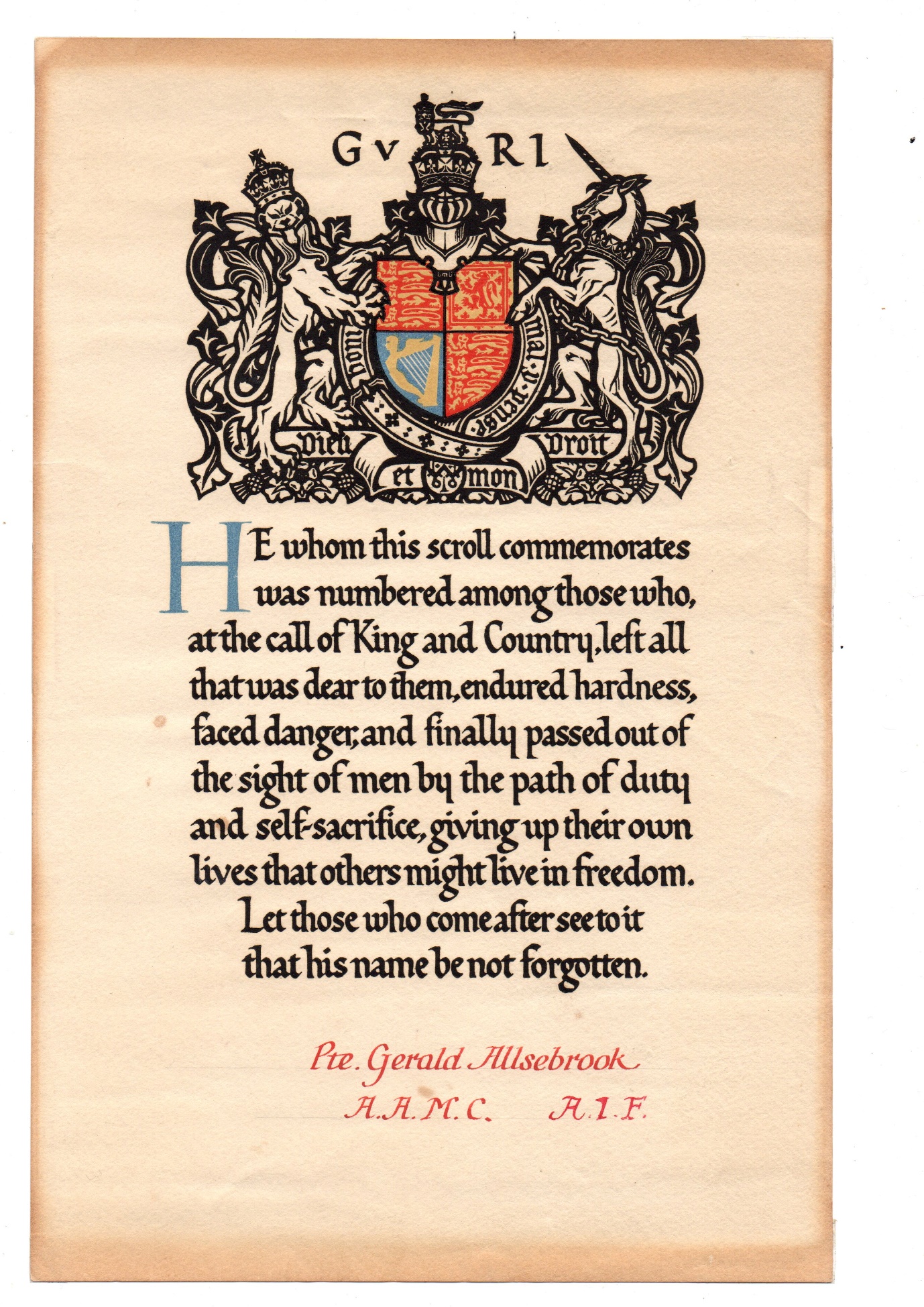 The museum only has his Memorial Scroll.
The museum only has his Memorial Scroll.
ANZAC Biographies
On our website you will find the biographical details of ANZAC (as well as British) servicemen & women whose medals or other memorabilia form part of the collection on display at the Maryborough Military & Colonial Museum, Maryborough, Queensland, Australia.